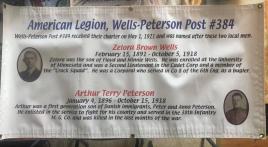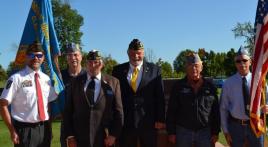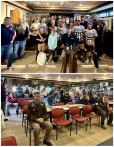The following is taken from articles written in “The Patriot Magazine” November/December 1994 issue, and “The Army Magazine” March 1995, by my uncle who has died. He served in World War II and the Vietnam War. He received the Silver Star for his actions with “The Last Flight of Miss Prissy.” I thought it might be of interest. I took the liberty of shortening the original writing by leaving out some of the detail.
The Last Flight of MISS PRISSY
By Major Chaplain Ralph F. Bates
Preferring to sit in the cockpit instead of facing the enemy on the ground I decided to try for the Army Air Force, specifically the cadet program, before being inducted. When I took the entrance exam I was only one out of 11 hopefuls to pass. This did wonders for my lack of self-confidence, but there were many hurdles to be crossed before my wife Ruthie was to pin pilot wings on me.
It wasn’t until Feb. 1, 1942, that I finally said goodbye to my family. The ride on the trip train to basic training in Atlantic City was like entering another world.
Ruhland: the very thought of it still brings chills to us when we remember that fateful dawn in southern Italy, when it all started. A date I will never forget, March 22, 1945. This was our 24th mission as part of the 817th B17 Squadron, 483rd Bombardment Group. We had to hurry over to the mess hall, gulp down some scrambled powdered eggs with coffee, pick up our lunch of peanut butter and jelly sandwiches, and get over to operations in time for the briefing. In the briefing room, I heard where we were flying that day. Our target was the oil depot in Ruhland, a city south of Berlin. It was our longest mission to date. Me-262 German Fighters are expected. P-51 fighters would be our escort and heavy flak was expected over the target. Due to the distance we would be caring only 10 500-pound bombs instead of the usual 12.
After approaching Miss Prissy and seeing her beautiful lines, all her armament and her four powerful engines, we did a visual check of the plane. Lt. Ralph Bates, pilot, Lt. Don Kallock, co-pilot, Lt. Don Fischer, navigator, Lt. Irving Jacobs, bombardier, Sgt. Harold Brewer, flight engineer, Sgt. Charles MacCauley, radioman, Jim Brennan, waist gunner, and Sgt. Pickard, gunner. We tossed our flight bags up into the belly hatch then swung ourselves up. After starting the four Wright Cyclone engines and going over the checklist, we were ready. The runway was higher at one and then the other with a sharp drop off at the high end and it was not unusual to have a B-17 ahead of us sink down and disappear. It was near panic until at last it rose into view. During the previous year a couple of them never made it. Now it was our turn. Checklist completed, we were now at the end of the runway waiting for the go ahead. At 71,000 pounds and caring a light bomb load we were still way over the 65,500 pound maximum which gave us pause since we were going to be taking off uphill. Miss Prissy lifted proudly off the runway and we felt the lift under her wings.
It was an awesome sight when we rendezvoused. We circled and climbed while other bombers caught up to form one gigantic attack force of up to 1,000 B-17s and B-24 bombers. On the long ride to Rutland we took time to check out our equipment and grab frozen peanut butter and jelly sandwiches.
Nearing the target, the bombardiers began calculating their bomb sights. On this mission it took seven minutes straight and level flight, which was mandatory. Evasive action was prohibited. Time never went so slowly.
It was terrifying to hear flak ricocheting against us, with the force of the explosions lifting and buffeting our plane. One shell blasted a hole in the fuselage near our radioman Sgt. Charles S. MacCauley. Smoke filled the interior. Miss Prissy was trembling from nose to tail.
Nevertheless, all bombardiers glued their eyes on the lead B-17, for when the bombs dropped from her it was time for them to toggle. It was always a relief dropping the bombs because then our group could make some turns and change altitude in an attempt to invade flak. The flak continued and enemy fighters were spotted. Then switching to intercom, I heard the boys shouting “Fighters at 6 o’clock!” Our ball tail and top turret 50-caliber guns started rattling just before a terrible explosion rocked the plane. Then another explosion occurred. After the Me-262 jets had paused behind us for the attack we could see them swinging swiftly by, ignoring their own comrades' flak.
At first it was hard for us to identify the jets because as they flew by through our contrails a strange refraction of light occurred. Wave after wave the fighters came, firing 30-mm cannons that exploded as they contacted our wings. The battle turned into a mighty convulsive and frenzy as other violent explosions rocked Miss Prissy.
We could see others in our formation going down. Lt. Bush’s aircraft suffered a direct flak hit in the wing and blew up in full view of our group, killing the whole crew.
Amid the chaos however, we helped bag one Me-262 and possibly another one. Meanwhile, fires were spreading rapidly along with the trailing edge of our right wing and a large fire burst out on the left wing.
In all, there were oil fires, hydraulic fluid fires, and fires fed by high-octane gasoline in our ruptured wing tanks. “Feather number four engine! Full turbos on number one and two!” Sgt. Brewer, always thinking, realized that number three engine was almost nil, and started pumping gas from the right wing tanks in to those on the left.
Our right wing started dipping causing us to drift away from the formation leaving us alone and unprotected. Suddenly, we were fresh meat for the first enemy fighter to come along and finish us off. They must have taken one good look at us and decided we were already finished off because they left us alone. We had a little time to fret however, because just then the gunners were shouting, “Fire increasing in both wings!” We were going down.
Our primary survival instincts took over. Now, in a dangerous flat clockwise spin, we had completely lost control of the plane. By sheer good fortune, Sgt. McCauley was the only person seriously injured. It was obvious we had to bail out. Yet, weighing the risks involved and I gave the crew the option of bailing out or staying in Miss Prissy. I decided to stay for the time being. All the crewmembers except for five in the forward section of the plane bailed out. The rest of us kept a totally unpredictable B-17 heavy bomber airborne until we could pass safely over hostile German territory.
We dove down to extinguish the fires, but they didn’t go out. We were going about 200 mph, which was 50 mph above cruising speed. Miss Prissy shook so badly it was it took three of us to handle her. Lt. Kallock, Sgt. Brewer and I remained on the throttles. A Me-262 was following us but soon left.
We leveled off at 5,000 feet and at 105 mph. At 102 mph we would stall because of the loss of wing surface. Now in a flat spin, with both wings on fire, large chunks of both wings blew apart, and the aluminum sheeting burned away, we had to decide again if it was worth the risk of staying with an airplane that was actually a bomb waiting to explode.
Still on a northeasterly course, we wanted to turn right, but when we tried to turn right the wing would start to dip beyond our control the same thing happened when we tried to turn left so we were forced to make a very gradual right turn which took us in a giant circle north of Berlin.
The fires in the wing were subsiding and we were holding steady at 5,000 feet so we are encouraged Then we spotted enemy aircraft below us. Curiously though, they left us alone. I guess they thought we were goners anyways.
Miss Prissy had held herself together for an hour and a half after being hit. We must have been protected by the angels from the ground fire that low-flying aircraft always attracted when crossing the front lines.
We thought we surely must be over friendly territory by now. We following a double track railway and soon spotted a small airfield where a number of smaller plants were parked. We fired the predesignated green flare and saw a green flash on the ground so we knew we were with friends. It didn’t matter, we still had to land.
There was a layer of puffy clouds just below us and as we flew through them and the turbulence induced another paroxysm in Miss Prissy and we were sure that after all we had gone through that might be the end.
Still another situation had to be dealt with. We were approaching a stranger airfield with a short runway while flying much too fast. Miss Prissy was threatening to stall any second. The airport fence had just passed under us. The right wheel wasn’t yet in lock position. We had no idea if indeed the tire was still inflated.
Coming into the airstrip low and way above landing speed, the airplane was now a missile. Hydraulic fluid had leaked everywhere and it was doubtful that we still had brakes. I waited until just before we landed to let down the flaps and we had barely passed over the fence and the right wing flap broke off. Fortunately were almost on the ground. The right wing was almost scraping the runway. We managed to land hard on the right wheel that Sgt. Brewer had just managed to crank down by hand. We discovered later that the right landing gear was made inoperable by a large piece of flak that had embedded itself into the right tire, but the tire hold up. After losing so much hydraulic fluid would we have enough pressure left to stop? The answer came when we finally stopped at the end of the runway. We were completely limp. Suddenly we realized that we no longer needed the love and protection of Miss Prissy. We still had no idea how much we owed the airmen who had maintained Miss Prissy and how much we depended on each other, and how much the Lord had cared for us.
We landed in Poland, and Russian soldiers were approaching. We couldn’t believe how our aircraft could have flown, after looking at the damage. Amazingly, all of us could stand in the place that was once part of the left wing, and that hole wasn’t half as big as the one on the right wing. What stunned me the most was when I stuck several fingers past the protective lining and fully into one of the large fuel tanks in the right wing. Further inspection revealed evidence 13 fires in the right wing and two in the left. All main spars in the right wing were riddled with shrapnel. Only the incredibly strong wing construction saved us. Both magnetos were shot out in number four engine. On number three, one magneto was shot out, and all but four of 12 spark plugs were hit.
It took a while for it all to sink in, but we shudder to think how close we came to giving it up for our country. Miss Prissy B-17 #46538 gave her all.




